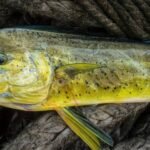Mahi-Mahi Dolphinfish: Fun Facts, Traits, Habitat, Behavior
Mahi-Mahi, Dolphinfish, or Dorado, is a fascinating fish species known for its striking appearance and strong fighting capabilities, making it a popular catch among sport fishermen. In this article, we’ll explore the physical characteristics, habitat, behavior, and more of this captivating fish.
Amazing Fun Facts
- Color Chameleons: Mahi-Mahi can change their colors rapidly due to specialized cells called chromatophores, which allow them to communicate, camouflage, and even show stress.
- Impressive Growth Rate: Mahi-Mahi exhibit one of the fastest growth rates among fish species, with some reaching up to 4 feet in length within their first year of life.
- Frenzied Feeding: Mahi-Mahi are known to go into a feeding frenzy when excited, attacking bait or lures with incredible speed, often leaping out of the water in the process.
- Prominent Forehead: Mature male Mahi-Mahi, or “Bull” Dorado, have a unique prominent forehead, while females have a more rounded head, making it easy to differentiate between the two sexes.
- Sargasso Weed Connection: Mahi-Mahi are often found near floating sargasso weed lines, as they provide protection and serve as a hunting ground for the fish, which feed on smaller organisms living among the weeds.
Quick Overview of Mahi-Mahi (Dorado) or Dolphinfish
| Attribute | Information |
|---|---|
| Scientific Classification | Kingdom: Animalia Phylum: Chordata Class: Actinopterygii Order: Carangiformes Family: Coryphaenidae Genus: Coryphaena Species: C. hippurus |
| Scientific Name | Coryphaena hippurus |
| Common Names | Mahi-Mahi, Dorado, Dolphinfish |
| Description & Appearance | Compressed body, iridescent blue pectoral fins, golden flank with black diagonal stripes, dazzling colors (golden, blues, greens), prominent forehead on mature males, females have rounded head and smaller size, capable of changing color out of water due to chromatophores |
| Size | Average 1 meter in length, can grow up to 2 meters |
| Habitat | Off-shore temperate, tropical, and subtropical waters |
| Distribution | Worldwide, including Pacific and Western Pacific regions |
| Diet | Carnivorous, feeding on various fish and crustaceans during daytime |
| Reproduction | Sexually mature at 4-5 months old, females spawn 2-3 times per year, producing between 80,000 and 1,000,000 eggs per event, spawning in pairs |
| Lifespan | Up to 5 years |
| Ecological Role | Prey for larger predatory fish, seabirds, and marine mammals, help maintain balance in marine ecosystems by controlling populations of smaller fish and crustaceans |
| Predators | Larger predatory fish, seabirds, marine mammals |
| Conservation Status | Listed as Least Concern on the IUCN Red List |
| Economic Importance | Important for sport fishing and commercial fishing industries, considered a delicacy and used for food |
| Human Interaction | Highly sought after for sport fishing and commercial purposes, consumption should be aware of potential food safety concerns such as ciguatera poisoning and scombroid food poisoning |
| Evolution | Mahi-Mahi have evolved a streamlined body shape, acrobatic swimming abilities, and color-changing capabilities for camouflage and communication |
| Adaptations | Chromatophores for color changing, compressed body for fast swimming, strong muscles for acrobatics, highly migratory behavior for finding food and spawning areas |
| Research and Discoveries | Ongoing research into Mahi-Mahi’s reproduction, migration patterns, and response to environmental changes, as well as the development of aquaculture techniques for sustainable production |
| Captivity and Aquarium Trade | Not commonly kept in home aquariums due to their large size and active swimming behavior, occasionally displayed in public aquariums and research facilities |
Physical Characteristics: A Dazzling Display

Mahi-Mahi are truly a sight to behold, with compressed bodies, iridescent blue pectoral fins, and golden flanks adorned with black diagonal stripes. Their dazzling colors range from golden to blues and greens. The most distinctive feature of mature males is their prominent forehead, while females have a rounded head and are generally smaller in size. Mahi-Mahi can change color out of water, thanks to their chromatophores, and they average around 1 meter in length but can grow up to 2 meters.
Habitat and Distribution: Adventurous Swimmers
These fish are found in off-shore temperate, tropical, and subtropical waters worldwide, including the Pacific and Western Pacific regions. They love swimming near debris and sargasso weed lines and can be found in depths from 0-85 meters near the coast or offshore under floating objects. Mahi-Mahi are highly migratory schooling fish, making them a fascinating species to observe and study.
Behavior: Fast and Furious
Mahi-Mahi can live up to 5 years and are carnivorous, feeding on various fish and crustaceans during the daytime. As juveniles, they swim in schools, while larger adult fish travel alone or in pairs. Their fast swimming and acrobatic capabilities make them highly sought after for sport fishing and commercial purposes.
Reproduction: Quick to Mature
Males and females are sexually mature in their first year, at just 4-5 months old. Females may spawn two to three times per year, every 2-3 days throughout the spawning season, producing between 80,000 and 1,000,000 eggs per event. Interestingly, Mahi-Mahi spawn in pairs rather than communally.
Fishing Methods and Locations: Catching the Prize

To catch Mahi-Mahi, look for floating debris and frigatebirds near the edge of the reef. Trolling with 30-to-50-pound gear and using ballyhoo or live sardines can excite them into a feeding frenzy.
Popular fishing destinations include Hawaii, the Gulf of Mexico, Costa Rica, Florida, and Southern California.
Mahi-Mahi are often found near seaweed, buoys, or debris and are caught using trolling, casting, and live baiting techniques.
Environmental and Food Safety Concerns: Be Aware
Mahi-Mahi are classified differently by sustainability rating systems, and it’s essential to be aware of potential risks associated with consuming them.
Ciguatera poisoning is common with this fish, and high levels of histidine may cause scombroid food poisoning.
Conservation Status: Least Concern
Mahi-Mahi are listed as Least Concern on the IUCN Red List, as they are a fast-growing species that can reach up to 4 feet in their first year, which makes them a relatively sustainable.
Common Names and Scientific Classification
Mahi-Mahi are also known as Dorado and Dolphinfish. Their scientific classification is as follows:
- Kingdom: Animalia
- Phylum: Chordata
- Class: Actinopterygii
- Order: Carangiformes
- Family: Coryphaenidae
- Genus: Coryphaena
- Species: C. hippurus
Harvest and Regulations: Know the Rules
U.S. commercial harvest of Mahi-Mahi is mostly from Hawaii, and they are harvested using troll and handlines. They are also incidentally caught in pelagic longline fisheries for tuna and swordfish. Recreational fishermen harvested 1.8 million pounds of Mahi-Mahi in 2021. Regulations vary by country, with some having size limits, bag limits, or restrictions on fishing methods.
Mahi-Mahi as Game Fish and Food: A Delicacy
Mahi-Mahi are prized for their vibrant colors and acrobatic jumps, making them a top choice for sport fishing enthusiasts. In addition to being a game fish, Mahi-Mahi are considered a delicacy and are used for food in various dishes, from pan-seared to grilled and baked.
FAQ
What are some popular Mahi-Mahi recipes?
Mahi-Mahi can be pan-seared, baked, or grilled, and pairs well with a variety of flavors and seasonings.
Where can I catch Mahi-Mahi?

Some popular Mahi-Mahi fishing locations include Hawaii, the Gulf of Mexico, Costa Rica, Florida, and Southern California.
What is the lifespan of Mahi-Mahi?
Mahi-Mahi can live up to 5 years.
How does Mahi-Mahi taste compared to tuna and salmon?

Mahi-Mahi has a mild, sweet flavor and firm texture, making it a versatile option for various dishes. It is less oily than salmon and has a milder taste than tuna.
Is Mahi-Mahi expensive and healthy?
Mahi-Mahi is generally considered a moderately-priced fish, and it is a healthy protein source, containing essential nutrients like omega-3 fatty acids, vitamins, and minerals. However, be aware of potential food safety concerns such as ciguatera poisoning and scombroid food poisoning.
How does Mahi-Mahi’s mercury and cholesterol levels compare to other fish?

Mahi-Mahi has lower mercury levels than some larger predatory fish like tuna and swordfish, making it a safer choice for regular consumption. As for cholesterol, Mahi-Mahi contains a moderate amount, similar to other fish species.

